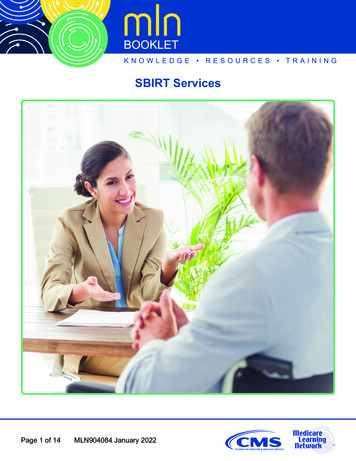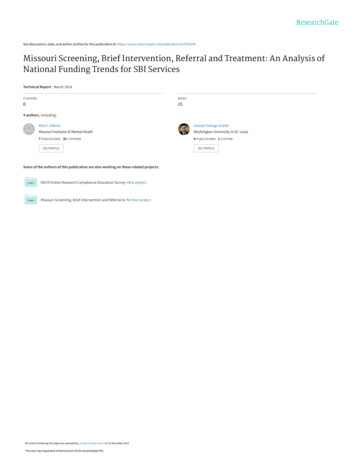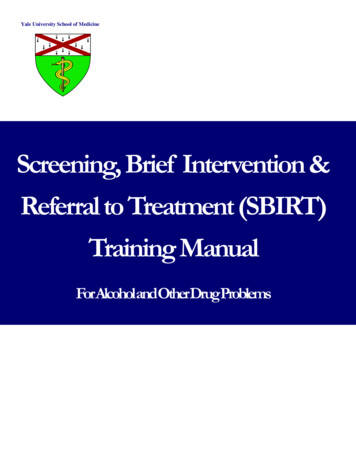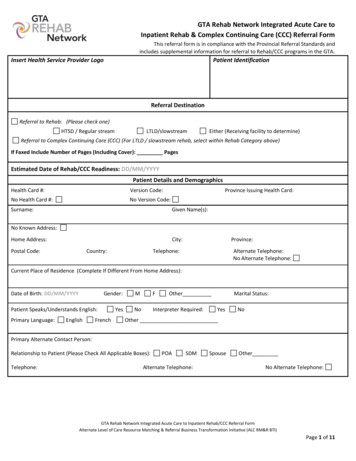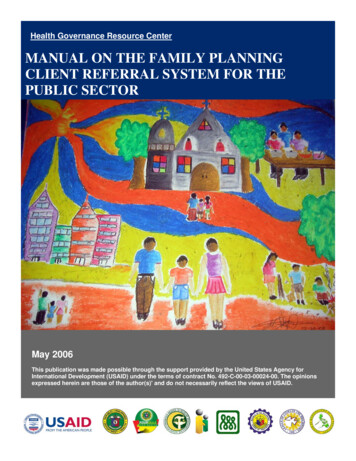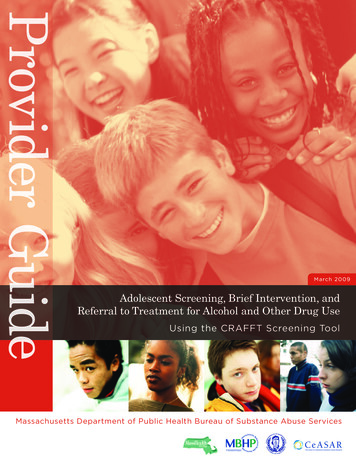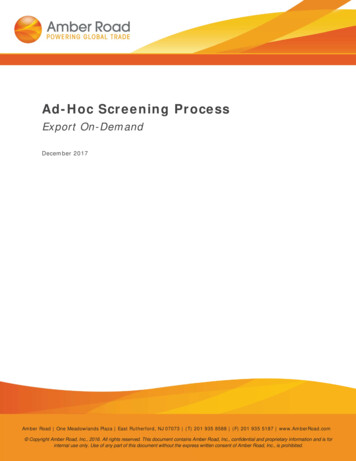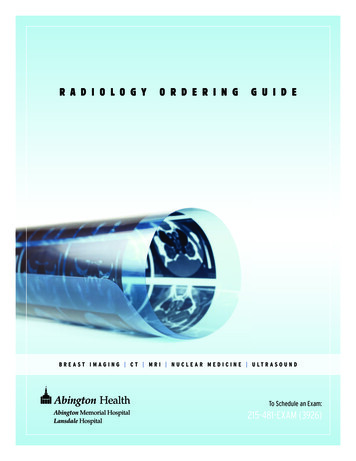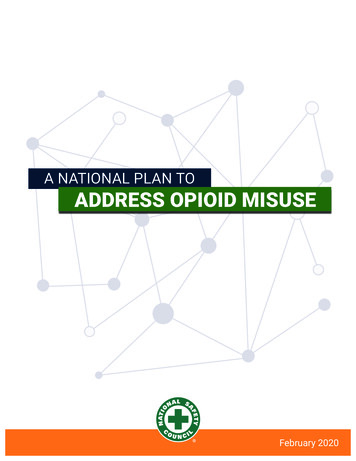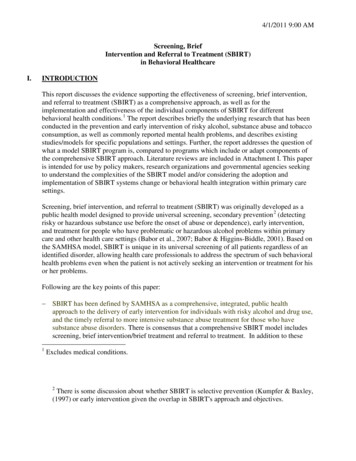
Transcription
4/1/2011 9:00 AMScreening, BriefIntervention and Referral to Treatment (SBIRT)in Behavioral HealthcareI.INTRODUCTIONThis report discusses the evidence supporting the effectiveness of screening, brief intervention,and referral to treatment (SBIRT) as a comprehensive approach, as well as for theimplementation and effectiveness of the individual components of SBIRT for differentbehavioral health conditions. 1 The report describes briefly the underlying research that has beenconducted in the prevention and early intervention of risky alcohol, substance abuse and tobaccoconsumption, as well as commonly reported mental health problems, and describes existingstudies/models for specific populations and settings. Further, the report addresses the question ofwhat a model SBIRT program is, compared to programs which include or adapt components ofthe comprehensive SBIRT approach. Literature reviews are included in Attachment I. This paperis intended for use by policy makers, research organizations and governmental agencies seekingto understand the complexities of the SBIRT model and/or considering the adoption andimplementation of SBIRT systems change or behavioral health integration within primary caresettings.Screening, brief intervention, and referral to treatment (SBIRT) was originally developed as apublic health model designed to provide universal screening, secondary prevention 2 (detectingrisky or hazardous substance use before the onset of abuse or dependence), early intervention,and treatment for people who have problematic or hazardous alcohol problems within primarycare and other health care settings (Babor et al., 2007; Babor & Higgins-Biddle, 2001). Based onthe SAMHSA model, SBIRT is unique in its universal screening of all patients regardless of anidentified disorder, allowing health care professionals to address the spectrum of such behavioralhealth problems even when the patient is not actively seeking an intervention or treatment for hisor her problems.Following are the key points of this paper: SBIRT has been defined by SAMHSA as a comprehensive, integrated, public healthapproach to the delivery of early intervention for individuals with risky alcohol and drug use,and the timely referral to more intensive substance abuse treatment for those who havesubstance abuse disorders. There is consensus that a comprehensive SBIRT model includesscreening, brief intervention/brief treatment and referral to treatment. In addition to these1Excludes medical conditions.2There is some discussion about whether SBIRT is selective prevention (Kumpfer & Baxley,(1997) or early intervention given the overlap in SBIRT's approach and objectives.
2integral components, SAMHSA defines a comprehensive SBIRT model to include thefollowing characteristics: It is brief (e.g., typically about 5-10 minutes for brief interventions; about 5 to 12sessions for brief treatments).The screening is universal.One or more specific behaviors related to risky alcohol and drug use are targeted.The services occur in a public health non-substance abuse treatment setting.It is comprehensive (comprised of screening, brief intervention/treatment, and referral totreatment).Strong research or experiential evidence supports the model’s effectiveness. No standard SBIRT definition has been articulated by the U.S. Preventive Services TaskForce or other authoritative/coordinating bodies. The SAMHSA definition of SBIRT is basedon methodology that was developed during the implementation of a comprehensive SBIRTgrant program comprised of all the integral components, and supported by research by theNational Institute on Drug Abuse and the National Institute on Alcohol Abuse andAlcoholism. There is substantial research on the effectiveness of SBIRT in reducing risky alcoholconsumption. However, the evidence for the effectiveness of SBIRT in reducing risky druguse, although promising, is still accumulating. The results for the SAMHSA model ofSBIRT for drug misuse are inconsistent depending on the characteristics of the provider, thespecific setting, and the patient population that is targeted for SBIRT implementation. Whilethere is robust evidence for screening and referral for depression in primary care, to date,little empirical evidence for the use of comprehensive SBIRT-like models for mental healthproblems commonly reported by health care patients. There is also no research that hasdemonstrated the implementation or effectiveness of SBIRT-like models in addressingtrauma or anxiety disorders in clinical health settings.II.THE SAMHSA SBIRT MODELSBIRT is a comprehensive, integrated, public health approach to the delivery of earlyintervention for individuals with risky alcohol and drug use, as well as the timely referral to moreintensive substance abuse treatment for those who have substance use disorders. Primary carecenters, hospital emergency rooms, trauma centers, and community health settings provideopportunities for early intervention with at-risk substance users before more severe consequencesoccur.SAMHSA supports a research based comprehensive behavioral health SBIRT model whichreflects the six following characteristics:1. It is brief. The initial screening is accomplished quickly (modal time about 5-10 minutes) andthe intervention and treatment components indicated by the screening results are completedin significantly less time than traditional substance abuse specialty care.
32. The screening is universal. The patients, clients, students, or other target populations are allscreened as part of the standard intake process.3. One or more specific behaviors are targeted. The screening tool addresses a specificbehavioral characteristic deemed to be problematic, or pre-conditional to substancedependence or other diagnoses.4. The services occur in a public health, or other non-substance abuse treatment setting. Thismay be an emergency department, primary care physician’s office, school, etc.5. It is comprehensive. The program includes a seamless transition between brief universalscreening, a brief intervention and/or brief treatment, and referral to specialty substanceabuse care.6. Strong research or substantial experiential evidence supports the model. At a minimum,programmatic outcomes demonstrate a successful approach.As a comprehensive or model approach, SBIRT has only been demonstrated to be effective forrisky alcohol use. There is substantial evidence for the effectiveness of brief interventions forharmful drinking when delivered by a physician or other qualified health professional (Bien et al,1993; Kahan et al, 1995; Wilk et al, 1993). There is a growing body of literature showing theeffectiveness of SBIRT for risky drug use (Madras et al, 2008; Saitz et al, 2010; Bernstein et al.,2005) but the results vary by the characteristics of the provider, the specific setting, and thepatient population that is targeted for SBIRT implementation.To determine the effectiveness of SBIRT beyond alcohol, a comprehensive literature review wasconducted. SBIRT-like models including not only a simple screening tool, but also anappropriate and brief intervention that addressed the level of problem indicated by the screeningresults. Table 1 (p. 4) identifies the substance abuse and mental health conditions where SBIRTor components of SBIRT have been employed. The literature review did not include studies thatemployed SBIRT or approaches that are similar to SBIRT for general medical conditions such asblood pressure, HIV/AIDS, or other behavioral issues such as domestic violence.As shown in Table 1, the comprehensive SBIRT model has not been consistently demonstratedas effective in addressing harmful or risky drug misuse, depression, trauma, or anxiety problems.Findings showing the effectiveness of SBIRT for drug misuse are accumulating, and there issome programmatic data from the SAMHSA State SBIRT programs showing promising findingsfor depression among primary care patients. Public health approaches that are consistent withthe SBIRT model have also been demonstrated for tobacco use. They are described in the lattersections of this paper. Table 1 presents a brief analysis of the evidence for the effectiveness ofSBIRT for various behavioral health conditions.
4Table 1. EFFECTIVENESS OF SBIRT AND ITS COMPONENTSFOR BEHAVIORAL HEALTH CONDITIONSBriefEvidence forBriefReferral to1Screening InterventionEffectiveness ofTreatment2 TreatmentSBIRTAlcoholMisuse/AbuseIllicit DrugMisuse/Abuse * * Comprehensive SBIRTeffective (Category Bclassification,USPSTF) Growing butinconsistent evidenceTobacco Use Depression — Trauma/AnxietyDisordersKey: *— Effective briefapproach consistentwith SBIRT (USPSTF;2008 U.S. PublicHealth Service (PHS)Clinical PracticeGuidelineNo evidence to date fordepressionNo evidence to date fortrauma/anxietydisordersEvidence for effectiveness/utility of component* Component Demonstrated to show Promising Results— Not Demonstrated and/or Not Utilized1Brief intervention as defined by the SAMHSA SBIRT program involves 1-5 sessions lasting 5minutes to an hour. Among SBIRT grantees funded by SAMHSA, about 15% of patients receivescores that indicate a brief intervention.2Brief treatment as part of SBIRT involves 5-12 sessions, lasting up to an hour. Among StateSBIRT grantees funded by SAMHSA, about 3% of patients receive a score that dictates a brieftreatment.
5Chart 1. FLOW CHART FOR SBIRT PROCESSScreeningUniversal screening helps identify the appropriate level of services needed based on the patient’srisk level. Patients who indicate little or no risky behavior and have a low screening score maynot need an intervention. Those who have moderate risky behaviors and/or reach a moderatethreshold on the screening instrument may be referred to brief intervention. Patients who scorehigh may need either a brief treatment or further diagnostic assessment and more intensive, longterm specialty treatment. Screening typically takes 5-10 minutes and can be repeated at variousintervals as needed to determine changes in patients’ progress over time. Some commonly usedscreens for the implementation of SBIRT for alcohol and drug use are the Alcohol Use DisordersIdentification Test (AUDIT), Drug Abuse Screening Test (DAST), Alcohol, Smoking, SubstanceInvolvement, Screening Test (ASSIST), and the Cut Down, Annoyed, Guilty, Eye-Opener(CAGE). In addition, a recent study found a single question related to drug use to be effective indetecting drug use among primary care patients (Smith et al., 2010).Prescreening, which is not a core component of SBIRT but is frequently used, reduces the timeneeded by busy clinic staff to identify patients with risky behavior. Examples of validated prescreens are the Alcohol Use Disorders Identification Test-Consumption (AUDIT-C), whichconsists of the first three alcohol consumption questions from the full 10-item AUDITquestionnaire, and the NIAAA prescreening question (“On any single occasion during the past 3months, have you had more than 5 drinks containing alcohol?”, Taj et al., 1998). If a patientscores high on any domain in the pre-screen, a full screen is conducted.Brief Intervention (BI) and/or Brief TreatmentPatients are provided with BI, brief treatment, or referral to intensive specialty treatmentdepending on their level of risk using a validated pre-screen and/or screening tool (Babor &Higgins-Biddle, 2001). With respect to substance abuse, in general only a small proportion ofpatients in primary care settings screened positive for some level of substance misuse, abuse ordependency. This is usually 5%-20%, but may be as high as 40% in some clinical settings. Themajority of patients report minimal or no problems with alcohol or drugs and as such may be anideal group for primary or universal prevention activities for maintenance of non-risky use orabstinence. The goal of a BI (which usually involves 1-5 sessions lasting about 5 minutes to onehour) is to educate patients and increase their motivation to reduce risky behavior.
6The goal of brief treatment (which usually involves 5-12 sessions) is to change not only theimmediate behavior or thoughts about a risky behavior but also to address long-standingproblems with harmful drinking and drug misuse and help patients with higher levels of disorderobtain more long term care. Based on performance data from state SBIRT grantees funded bySAMHSA, only about 3% receive a score that indicates a brief treatment. Patients referred to abrief treatment often have higher risk factors than those referred to a BI. Brief treatment mayalso require a manualized course of (advanced) motivational enhancement and cognitivebehavioral approaches to help patients address unhealthy cognitions and behaviors associatedwith current use patterns and adopt change strategies. If patients report greater risk factors thanwhat brief treatment can address, they are referred to specialty substance abuse care. In somecases, a patient may receive a BI first and then move on to a brief treatment or longer term care.Although the time required to execute BI/BT is generally considered brief, it is far too lengthyfor physicians to do. Also, physicians cite concerns about angering or insulting patients bybringing up sensitive issues such as alcohol and/or drug use. While these concerns areunderstandable, when SBIRT is implemented properly, the time commitment is reasonable andacceptably low given the demonstrated success in identifying persons requiring referral totreatment (RT). Similarly, concerns about patient reactions can be neutralized by proper trainingfor the providers and ensuring that access to referral services is available. In addition, SBIRT isfrequently implemented by allied health professionals such as nurses, social workers, or healtheducators, with results and actions noted in the patient chart for physician notification andoversight.Referral to Treatment (RT)Referral to treatment can be a complex process involving coordination across different types ofservices. As such, the absence of linkages to treatment referrals can be a significant barrier to theadoption of SBIRT. Referral is recommended when patients meet the diagnostic criteria forsubstance dependence or other mental illnesses as defined by the Diagnostic and StatisticalManual of Mental Disorders, Fourth Edition (DSM-IV). 3 In these cases, a referral to aspecialized treatment provider is often made. Referral requires the primary care system toestablish new and complex linkages with the traditional specialty care system to connect clientswho score in the problematic range to recognized, evidence based treatment in a timely manner.Although only 3% to 4% of screened patients in primary care settings typically need to bereferred, the absence of a proper treatment referral will prevent the patient from accessingappropriate and timely care that can impact other psychosocial and medical issues. Researchfindings suggest that motivational-based BIs can increase patient participation and retention insubstance abuse treatment (Hillman et al., 2001; Dunn and Ries, 1997). Strong referral linkagesare critical, as well as tracking patient referrals. SAMHSA requires SBIRT grantees to have acomprehensive referral to treatment and follow-up system in place for the duration of theprogram. In the case where RT is incorporated into an integrated care model, this may requireshifts in provider allocation and hiring.3The diagnostic criteria are likely to change when DSM V is released in 2012 or 2013.
7The following characteristics of SBIRT identified in the research literature (see Referencesection) have been shown to be important in effectively addressing behavioral health problems.They have therefore formed the foundation for the SAMHSA SBIRT programs.1) Use of brief, validated, universal pre-screening/screening tools. These tools allow health careprofessionals to address the problem behavior even when the patient is not actively seekingtreatment for his or her problem. Prescreening/screening tools accurately and quickly identifyindividuals with problematic conditions in as little time as 2-4 minutes. Because of itsbriefness and its universal application (that is, can be used with all patients), SBIRT may bemore generally accepted by health care professionals working in busy practices.2) Relatively easy to learn by diverse providers. The SBIRT approach is easy to learn relative toother behavioral treatment techniques that may require lengthy specialized training. As such,it can be implemented by diverse health professionals who work in busy medical settingssuch as physicians, nurses, social workers, health educators and paraprofessionals.3) Incorporation of strong referral linkages to specialty treatment. Approaches that are effectiveintegrate comprehensive strategies that include referral to specialty treatments (Gentillelo,Donavan, Dunn & Rivara, 1999). While RT may be difficult in underserved areas, thisshould not deter programs from engaging in developing SBI activities as they have beneficialeffects separate from the referral. However, the goal is to provide a quick handoff fordependent patients to specialty treatment if the primary care site cannot provide moreintensive services for substance abuse. Establishing linkages with specialty care throughidentification of local treatment service contracts, an MOU agreement between sites, ordedicated central referral services has been a major barrier for many providers in theirdecision to adopt SBIRT. The availability of well established referral linkages to specialtycare is essential to the uptake and maintenance of SBIRT, and closely tracking to confirmpatient compliance with treatment is critical to good health care provision. Primary carelocations engaged in referral to specialty care make efforts to determine the patient’sengagement and participation in treatment, as this may also affect the course of treatment inthe general medical practice.III.ALCOHOL MISUSE, ABUSE, AND PREVENTIONThere is substantial evidence from review studies (Babor, 2007; Bein et al, 1993; Kaner, et al.,2009) and meta-analyses of randomized clinical trials (Beich et al., 2003; Bertholet et al, 2005)that show the effectiveness of SBIRT in reducing hazardous drinking in patients presenting inprimary care and other health care settings. The U.S. Preventative Services Task Force(USPSTF) has recommended that “behavioral counseling interventions for risky/harmful alcoholuse among adult primary care patients can provide an effective public health approach toreducing problematic drinking” (USPSTF, 2004). The USPSTF also concluded that counselingfor risky drinkers should include advice to reduce current drinking; feedback about currentdrinking patterns; and explicit goal-setting, usually for moderation and assistance in achievingthe goals.
8Research also indicates that despite the robustness of the evidence for SBIRT’s effectiveness forunhealthy alcohol drinking, other factors can impact its effects. For example, studies haveshown that multiple contacts or sessions (in contrast to a single contact) with a provider canincrease the impact of SBIRT in reducing risky alcohol consumption (Brown et al., 2007;Longabaugh et al., 2001). Moreover, demographic factors and psychosocial conditions alsohave been shown to influence SBIRT’s effects on alcohol misuse (Saitz et al., 2006). Forexample, homelessness makes SBIRT less effective due to the challenges involved in workingwith this population, and brief interventions have improved linkages with those who can provideassistance to younger men and hospitalized women.The conduct of universal screening, brief intervention and treatment, and referral to treatment foralcohol disorders has been found to be effective in various healthcare settings for diverse patientpopulations including primary care (Babor et al., 2007), emergency departments (Gentilello etal., 1999), as well as schools and colleges (O'Brian et al., 2006). Data are currently beingcollected that suggest that SBIRT may also be effective in addressing alcohol problems inemployee assistance programs (McPherson and Goplerud, 2008). Recent research also hasdemonstrated the efficacy of conducting screenings and BIs using innovative strategies such asthe use of personalized feedback via the internet (Cunningham, 2010), as well as web-basedoutcomes monitoring to assist with treatment decisions and cognitive behavioral techniques(Roy-Bryne, 2010).Also promising is the utilization of computerized interventions which has been shown to beeffective in augmenting and complementing the gains made through the initial face to face briefinterventions. The Veterans Administration, for example, examined the use of electronic clinicalreminders with patients following screening with the AUDIT-C and showed such approachesreinforced moderate drinking reductions at follow up (Williams, 2010). Other research reviewsindicate that electronic methods can enhance brief interventions with substance users by offeringassessment and feedback in brief motivational interviewing; monitoring individual treatmentpatient’s progress; tracking patients in aftercare; and providing educational opportunities forclinicians (Cucciare, 2009). Electronic intervention can also help bridge the treatment capacitygap by providing another source of assistance for women who do not complete traditionalsubstance abuse treatment (Van DeMark, et al., 2010). In addition, the cost savings offered bythe implementation of SBIRT in primary care are significant. One study (Gentilello, 2005)showed that for every one dollar spent on providing SBIRT approximately 3.81 is saved. TheWashington State SBIRT program cost study also reflects similar savings.The concept of SBIRT can be applied across the continuum of care for alcohol problems. Basedon the severity of the problem indicated by the screening results, interventions ranging fromuniversal prevention to brief interventions to traditional specialty treatment can be provided tohealth care patients. For individuals who are abstinent, universal prevention practices can beimplemented to sustain alcohol abstinence. For moderate risky drinking, the first twocomponents of SBIRT – screening and brief interventions (SBI)– may be implemented whichcan address inappropriate expectancies (beliefs about substance use effects and social norms ofacceptable behavior) and lack of motivation to change risk factors that contribute to substanceabuse (Dimeff et al., 1999).
9Extensive research supports screening and brief intervention as effective universal and selectiveprevention strategies for alcohol problems. Universal screening with educational content hasmeasurable prevention effects with accompanying feedback (Kunz et al., 2004). The preventionapproach may also be successful for abstainers and non-risky drinkers by providing behavioralsupport and normative information to maintain healthy behaviors. For at-risk individuals, earlyidentification and brief intervention around false expectancies, normative use misperceptions andskills acquisition can prevent progression to severe drinking problems. For example, theBASICS program, which is consistent with the SBIRT approach, has been shown to be effectivein addressing problematic or risky drinking in college age groups (Dimeff et al., 1999). SBIs alsoincorporate motivational interviewing components (Miller and Rollnick, 2002) that are alsointegrated in brief treatment for higher risk patients. SBIs have proven effective in decreasingoverall consumption and binge drinking (Casset et al., 2008; Hanewinkel & Wiborg 2005; KunzJr. et al., 2004; Martens et al., 2007; Heather et al., 2004; Toumbourou et al. 2007; Murphy et al.,2001), as well as increasing productivity (Osilla et al., 2010). Evidence further demonstrates thatstrengthening resiliency, competencies, and social connectedness supports recovery for thoseindividuals who show early symptoms of alcohol misuse.Extensive reviews of the effectiveness of SBI (Babor et al., 2007, 2008) have found that there are“irrefutable” improvements in short-term health benefits as well as indications of “substantial”long-term benefits. Follow up at three, six or nine month intervals can help document theeffectiveness of SBI and reinforces normative ideation and skills enhancement for individualswith minimal risk behaviors. To achieve long term effects, SBI must be implemented withfidelity through targeted training for providers (Cameron et al., 2010; Seale et al., 2005;Christensen et al., 2004; Bray et al., 2009; Ronzani et al., 2008; Furtado et al., 2008; Heather etal., 2004; Tollison et al., 2008; Babor et al., 2004; Brown & Fleming, 1998). In many instancesproviders implementing SBI may not necessarily be physicians but allied health professionalssuch as nurses, counselors, health educators, and peers (Mastroleo, 2009; Blume & Marlatt,2004), who may experience fewer barriers in service provision than physicians (Babor et al.,2004). Also, SBI can be conducted individually or with groups (Shellenberger et al., 2009;Henslee, 2009), with web-based instruments (i.e. college oriented E-Chug and E-Toke orAlcohol Skills Training Programs), or online feedback (Blume & Marlatt, 2004), and appliedthrough strategic planning by communities or providers.IV. DRUG MISUSE, ABUSE, AND PREVENTIONIn 1995, based on the scant availability of published research on SBIRT for drugs, the USPSTF(1995) determined that there was “insufficient evidence to recommend for or against” theeffectiveness of using an SBIRT approach for drugs. Some researchers have cited the relativescarcity of validated brief drug screening tools (Smith PC, et. al., 2010) and the low prevalencerates of drug use (Saitz, 2010) in primary care settings, as two reasons for the comparativelysmall number of studies showing SBIRT’s effects with drugs (De Micheli D, et. al., 2004).Nevertheless, since 1995, there has been a growing body of investigator-initiated research aswell as findings from SAMHSA-funded SBIRT projects that have shown promising results forthe use of the comprehensive SBIRT approach, as well as selected use of individual components,in reducing risky drug use (Copeland et al., 2001). For instance, a randomized controlled trialindicated that BIs can reduce cocaine and heroin use (Bernstein et al., 2005). Motivational
10interviewing coupled with a self-help booklet given to regular amphetamine users also resultedin reduced levels of drug use (Baker, Lee, Claire, Lewin, Grant, & Pohlman, 2005). BIs forpatients screening positive for cocaine, heroin, and amphetamine are also showing promisingresults in various settings beyond emergency departments (Cunningham et al., 2009). In smallsample sizes, screening and BIs have been linked with reductions in the use of marijuana,amphetamine-type stimulants, cocaine, and heroin (Madras et al., 2008). The World HealthOrganization (2008) sponsored a multi-national study demonstrating that screening and briefinterventions resulted in short-term reductions of a wide variety of illicit drugs, includingmarijuana, cocaine, amphetamine-type stimulants, and opioids.As with alcohol consumption, universal and selective prevention efforts may also be targeted tothose with minimal or mild drug misuse. Like with alcohol, identified abstainers can benefitfrom supportive and normative information to maintain healthy lifestyles. For individuals at riskfor drug problems, early identification and brief intervention around false expectancies and skillacquisition can prevent progression to more severe drug problems. In addition, tools that can beused for universal screening of drug use in health settings such as the DAST and the ASSIST aswell as on-line tools such as E-TOKE (Electronic – THC Online Knowledge Experience) areprevention-ready applications designed to detect the presence of drug use.V. SBIRT AND TOBACCO USEThe utility of SBIRT approaches for all forms of tobacco use, especially smoking, has beenendorsed by the USPSTF and has elicited interest in primary care and hospital personnel.Cigarette smoking continues to be the leading cause of preventable disease and death in theUnited States (USDHHS, 2004) and is attributed to approximately 443,000 deaths per year(CDCP, 2010) from lung cancer: ischemic heart disease, chronic obstructive pulmonary disease,strokes, and other diagnoses. Smoking also affects health outcomes of people other than thesmokers, with smoking during pregnancy resulting in premature births, spontaneous abortions,stillbirths, and intrauterine growth retardation. In addition, research has shown that psychiatricdisorders and cigarette smoking are frequently co-morbid conditions (Dome et al, 2010; Brownet al, 2008; Brown et al, 2002; Degenhardt & Hall, 2001; Grant et al, 2004). A recent studyusing data from the 2005-2006 National Survey on Drug Use and Health reported that adultswith lifetime depression, anxiety, anxiety with depression, or major depressive episodes weremore likely to be “current smokers, smoke with higher intensity and frequency, have moredependence, and have lower success at quitting” when compared to individuals without thesepsychiatric conditions (Trosclair & Dube, 2010).However, despite smoking's established risks and the health benefits of quitting, 23 percent ofadults in the United States continue to smoke and more than 2,000 adolescents become regulartobacco users daily (NSDUH, SAMHSA). Nearly 90 percent of smokers start by age 18, and 25percent of teen smokers remain addicted as adults. Because 70 percent of smokers see aphysician each year (Fiore, Bailey, Cohen, et al., 2000) clinicians have a unique opportunity tointervene and implement tobacco SBIRT in primary care settings and emergency departments.As such, the USPSTF strongly recommends that clinicians screen all adults for tobacco use andprovide brief interventions, including screening, brief behavioral c
Clinical Practice Guideline — . Chart 1. FLOW CHART FOR SBIRT PROCESS ; Screening ; Universal screening helps identify the appropriate level of services needed based on the patient's risk level. Patients who indicate little or no risky behavior and have a low screening score may
